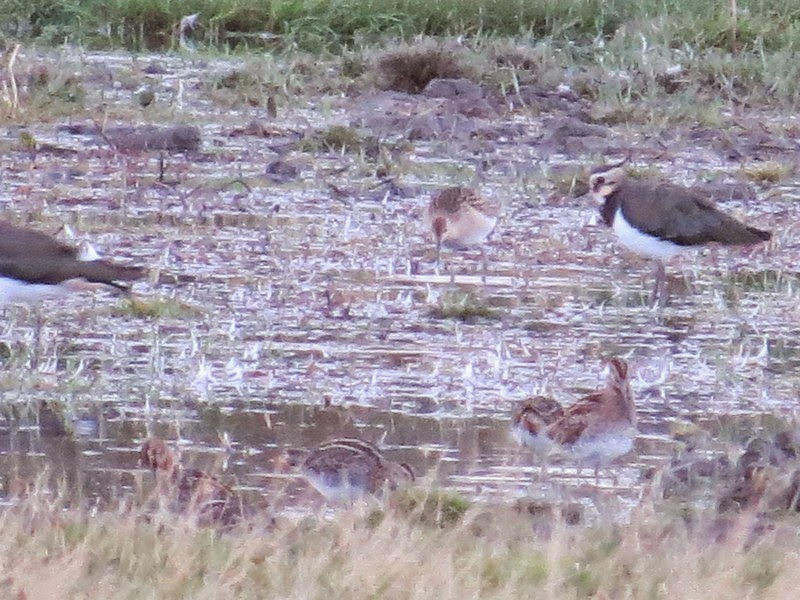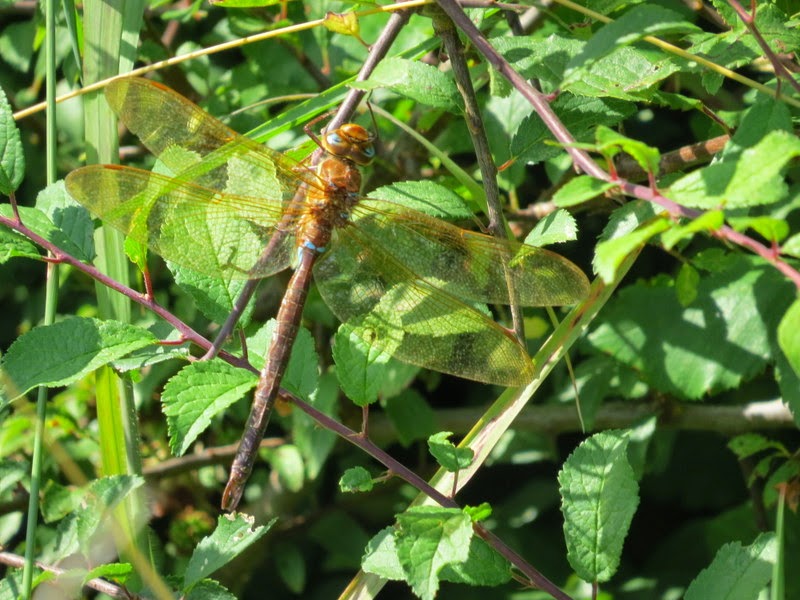Well it's that time of year again. Sunday, August 24. A dawn to (nearly) dusk attempt to see as many species at the patch as possible. I didn't do one last year, so I have to look back to 2012 for my comparison. That one was a few days later and produced a rather disappointing total of 57 species, although they did include a long-staying Wood Sandpiper, plus Redstart, and Whinchat. I was determined to do better this time.
So I was on the patch at 5.30am by which time it was too dark to see birds, but light enough to see my notebook. The first birds were the ever quacking Mallards, shortly followed by my main target for the early start, several calling Tawny Owls.
I spent a couple of hours wandering around, the cold, still air encouraging mist to form over the flashes and pool. At the time, the highlight seemed to be a Sparrowhawk (although I did see one in the evening as it turned out). There were three species which I only recorded on this early jaunt, the Tawny Owls, plus a Common Snipe which flew out of the marsh, and a Coal Tit at the edge of Bannams Wood, so it was just about worth the effort.
After a break for breakfast I was back on the patch, this time at Netherstead. Dave joined me after his holidays, and he soon found the first good birds of the day as two juvenile Peregrines shot passed. Later, one of them circled overhead, the first since the spring.
 |
| Juvenile Peregrine |
I had been fretting slightly at the apparent lack of Warblers from my early visit. Perhaps their numbers were greatly reduced. I needn't have worried, the hedgerow by the barn produced a Willow Warbler, two Whitethroat, and a Lesser Whitethroat, and we soon had a magical half hour by the small pond as we were surrounded by flicking, calling warblers including two Reed Warblers. We also saw some juvenile Bullfinches, and then a Kingfisher flew in and landed briefly in the dense branches of a pollarded willow.
 |
| 93 Kingfisher |
On the basis that I may not get a second chance, I am adding this dreadful record shot to my photo year list.
We headed on to the flashes, seeing more Warblers including a second Willow Warbler. The flashes produced no new waders, but the six Green Sandpipers, and 28 Teal were at least joined by a Wheatear, the first of the autumn.
Dave spotted a Hobby, which I just got onto, but that was our last day tick before Dave headed for home. I had other ideas and headed back to the flash. A Grey Heron rose from the pool, and I found that the Hobby was catching dragonflies. Matt Willmott had seen it on Thursday so I was half expecting it would be there. It then disappeared, but I relocated it at the flash, and was pleased to find it was regularly perching in the dead tree.
 |
| 94. Hobby |
It was interesting that its regular sorties over the flash barely disturbed the Lapwings and Green Sandpipers feeding there. It was as though they knew it was only after dragonflies. I walked back through the weedy field, and this tactic, as expected, added Skylark to the day list. I was eventually back home at 2pm, feeling completely knackered, but with 61 species to my name.
After lunch, plus half an hour crashed out on the sofa, I was back in the field for the late afternoon shift with a small list of birds I was hoping to see. Walking through the village I bumped into two ladies who sometimes walk the Harvey's dogs doing just that, but being followed by Fluffy, the Harvey's cat. They were very anxious to encourage it to go home and so I ended up grabbing the moggy and carrying it back home. No birds then. I then resumed the walk and at Bannams Wood I heard a Nuthatch call. One down. I continued to Church Farm and then down the hedge-line. Over the pool to my left was another day tick, Black-headed Gull. Two down. Finally, although no waders had turned up (surprise surprise) the Flashes did at least produce my final day tick in the form of five Starlings. A grand total of 64 species, only one fewer than my spring big day.
The now obligatory Badger lolloped along the fence at the far edge of the flash field, and I then walked into Mike Lane and (Peter Preece ?) preparing to set up a hide with the intention on photographing this same Badger at the pool. Good luck guys.
Major misses were Pied Wagtail (they just seem to have abandoned the place, and my guess is that they have found a nice ploughed field somewhere and are all there), Treecreeper and Goldcrest (certainly present but elusive).
No year ticks, but a pretty satisfactory day.
The full list
1. Greylag Goose 2. Canada Goose 3. Teal 4. Mallard 5. Tufted Duck 6. Red-legged Partridge 7. Pheasant 8. Grey Heron 9. Little Grebe 10. Sparrowhawk 11. Buzzard 12. Kestrel 13. Hobby 14. Peregrine 15.Moorhen 16. Coot 17. Lapwing 18. Green Sandpiper 19. Snipe 20. Black-headed Gull 21. Lesser Black-backed Gull 22. Stock Dove 23. Woodpigeon 24. Collared Dove 25. Tawny Owl 26 Kingfisher 27. Green Woodpecker 28. Great Spotted Woodpecker 29. Magpie 30. Jay 31. Jackdaw 32. Rook 33. Carrion Crow 34 Raven 35. Blue Tit 36. Coal Tit 37. Great Tit 38. Marsh Tit 39. Skylark 40. Swallow 41. House Martin 42. Long-tailed Tit 43. Chiffchaff 44. Willow Warbler 45. Blackcap 46. Whitethroat 47. Lesser Whitethroat 48. Reed Warbler 49. Nuthatch 50. Wren 51. Starling 52. Blackbird 53. Song Thrush 54. Robin 55. Wheatear 56. Dunnock 57. House Sparrow 58. Chaffinch 59. Bullfinch 60. Greenfinch 61. Linnet 62. Goldfinch 63. Yellowhammer 64. Reed Bunting

























